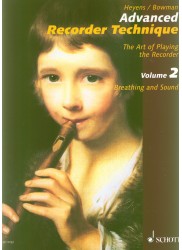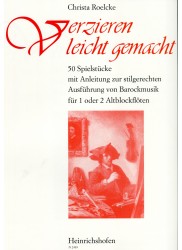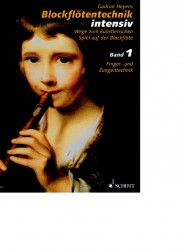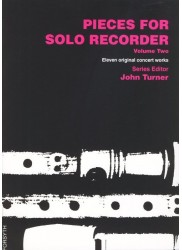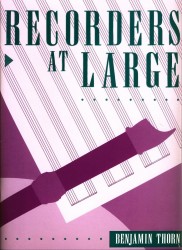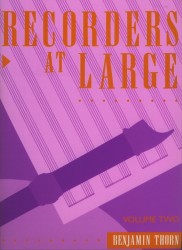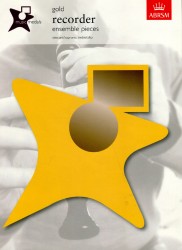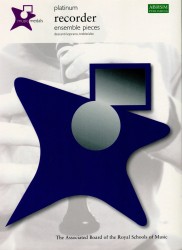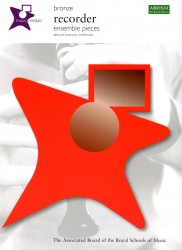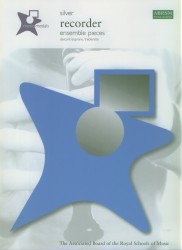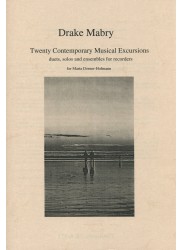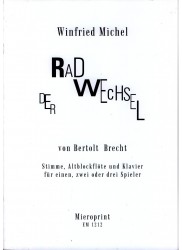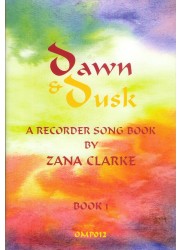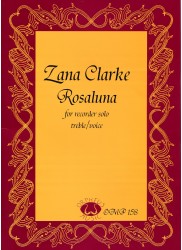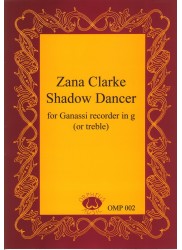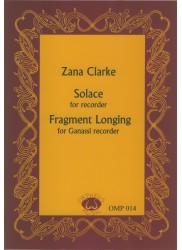No products
Prices are tax included
Asiadeh and other songs
Composer: Cogan - Racheal
Instrumentation: Treble
Period/genre: Contemporary
Grade: Difficult
More info
*Contemporary Pieces.*
Four fascinating pieces using middle eastern forms and idioms. Can be used as the basis for improvisations or played with other instruments. MD
_Part 8 pp._
OMP112 Racheal Cogan Asiadeh and other songs for treble recorder
This new volume from Racheal Cogan comprises four songs in total: "Asiadeh", "Panjaneh", "Waltz" and "Maya". It is well conceived and a must for any players looking for something a little different. The pieces were originally written for a Ganassi alto in G, though they are here presented in a version for standard treble recorder. Both the songs and performing style are greatly influenced by Cogan's studies of eastern Mediterranean music, especially Greek and Turkish. And her preface indicates many ideas, e.g. ornamentation and improvisation, which are appropriate for the performance of this music.
"Asiadeh" is described as rhythmically a karsilana: a Turkish dance in 9. Interestingly 9/8 here presents itself as 3/4 + 3/8 - guaranteed to keep players on their toes. The acciaccaturas will also keep you alert as the Majority of them are connected to the note which precedes them, rather than, and more normally, note which succeeds them.
"Pajaneh" is in 5/8 and again features lots of ornamentation. With a D Major key signature the turn on upper B will require some consideration, as will the mordents on upper A# - how narrow or how wide an interval will be apt here? Something left very much to the players' personal taste.
"Waltz" is rhythmically much more straightforward, although again the acciaccaturas help to complicate matters. The quartertone B flat, for which the fingering 0123/4--- is suggested, is also a feature early in the piece.
"Maya" is in 6/8 and with its occasional wide leaps compares to some of Telemann's writing in the Fantasies. Written in a sort of rondo form, there is an eight bar Teslim (borrowed from classical Turkish music) sandwiched between each of the five sections like a chorus.
However you decide to perform these songs - as solos, in unison with other instruments, with a drone accompaniment, or even with percussion - they present the musicians with an interesting and rewarding challenge. Well worth studying, especially if you're looking for a change from the usual fare.
Adam J Dopadlik The Recorder Magazine, Summer 2004
30 other products in the same category:
Reference: ED9762
Brand: Schott
Advanced Recorder Technique: The Art of Playing the Recorder Vol 2: Breathing...
Composer: Heyens/Bowman Instrumentation: Treble Grade: Moderate - Difficult
In StockReference: N2483
Brand: Noetzel
Ornamentation made easy
Composer: Roelcke - Christa Period/Genre: Baroque Grade: Difficult
In StockReference: ED9401
Brand: Schott
Blockflotentechnik Intensiv
Composer: Heyens - Gudrun Instrumentation: Treble Grade: Moderate -...
In StockReference: FZZ04
Brand: Forsyth
Pieces for Solo Recorder Volume 2: Eleven Original Concert Works
Composer: Various (See below) Instrumentation: Descant/Treble/Tenor...
In StockReference: HE32394
Brand: Alfonse Leduc
Les Concertos De JS Bach
Composer: Bach - Johann Sebastian Arranger: Michel Sanvoisin...
In StockReference: BT001
Brand: Currency Press
Recorders at Large Vol 1
Composer: Thorn - Benjamin Instrumentation: Descant/Treble Period/genre:...
In StockReference: BT002#
Recorders at Large Vol 2
Composer: Thorn - Benjamin Instrumentation: Descant/Treble Period/genre:...
In StockReference: 9781860966057
Brand: ABRSM
Music Medals: Gold Recorder Ensemble Pieces
Composer: ABRSM Instrumentation: Descant/Treble - various combinations...
In StockReference: 9781860966064
Brand: ABRSM
Music Medals: Platinum Recorder Ensemble Pieces
Composer: ABRSM Instrumentation: Descant/Treble - various combinations...
In StockReference: 9781860966033
Brand: ABRSM
Music Medals: Bronze Recorder Ensemble Pieces
Composer: ABRSM Instrumentation: Descant/Treble - various combinations...
In StockReference: 9781860966040
Brand: ABRSM
Music Medals: Silver Recorder Ensemble Pieces
Composer: ABRSM Instrumentation: Descant/Treble - various combinations...
Out of stockReference: FEA171
Brand: Flautando Edition
Twenty Contemporary Musical Excursions
Composer: Mabry - Drake Instrumentation: Treble/2 Trebles/3 Trebles...
In StockReference: EM1212
Der Rad Wechsel
Composer: Michel - WinfriedInstrumentation: 2 Descants - Treble - Tenor - 2...
In StockReference: OMP012
Brand: Orpheus Music
Dawn and Dusk Book 1
Composer: Clarke - Zana Instrumentation: Descant - Treble Period/genre:...
In StockReference: OMP012.pdf
Brand: Orpheus Music
Dawn and Dusk Book 1
PLEASE NOTE - DOWNLOADABLE PDF VERSION Composer: Clarke - Zana...
$22.00 -20%In StockReference: OMP158
Brand: Orpheus Music
Rosaluna
Composer: Clarke - Zana Instrumentation: Treble - Voice - one player...
In StockReference: OMP158.pdf
Brand: Orpheus Music
Rosaluna
PLEASE NOTE - DOWNLOADABLE PDF VERSION Composer: Clarke - Zana...
$13.00 -20%In StockReference: OMP015
Brand: Orpheus Music
Swamp
Composer: Clarke - Zana Instrumentation: Treble - Voice - one player...
In StockReference: OMP015.pdf
Brand: Orpheus Music
Swamp
PLEASE NOTE - DOWNLOADABLE PDF VERSION Composer: Clarke - Zana...
$13.00 -20%In StockReference: OMP002
Brand: Orpheus Music
Shadow Dancer
Composer: Clarke - Zana Instrumentation: Treble Period/genre: Australian...
In StockReference: OMP002.pdf
Brand: Orpheus Music
Shadow Dancer
PLEASE NOTE - DOWNLOADABLE PDF VERSION Composer: Clarke - Zana...
$13.00 -20%In StockReference: OMP014
Brand: Orpheus Music
Fragment Longing/Solace
Composer: Clarke - Zana Instrumentation: Treble Period/genre: Australian...
In StockReference: OMP014.pdf
Brand: Orpheus Music
Fragment Longing/Solace
PLEASE NOTE - DOWNLOADABLE PDF VERSION Composer: Clarke - Zana...
$13.00 -20%In StockReference: OMP107
Brand: Orpheus Music
Mind Your Step
Composer: Clarke - Zana Instrumentation: Treble Period/genre: Australian...
In StockReference: OMP107.pdf
Brand: Orpheus Music
Mind Your Step
PLEASE NOTE - DOWNLOADABLE PDF VERSION Composer: Clarke - Zana...
$14.50 -20%In StockReference: OMP001
Brand: Orpheus Music
Behind My Right Shoulder
Composer: Clarke - Zana Instrumentation: Descant/Treble + Voice...
In StockReference: OMP007
Brand: Orpheus Music
Dawn and Dusk Book 2
Composer: Clarke - Zana Instrumentation: Descant/Treble Period/genre:...
In StockReference: OMP007.pdf
Brand: Orpheus Music
Dawn and Dusk Book 2
PLEASE NOTE - DOWNLOADABLE PDF VERSION Composer: Clarke - Zana...
$22.00 -20%In StockReference: OMP001.pdf
Brand: Orpheus Music
Behind My Right Shoulder
PLEASE NOTE - DOWNLOADABLE PDF VERSION Composer: Clarke - Zana...
$17.50 -20%In StockReference: YCS018
Brand: Orpheus Music
A Baker's Dozen of Carols
Composer: Coburn - Charlotte Instrumentation: Descant - Treble (played...
In Stock
